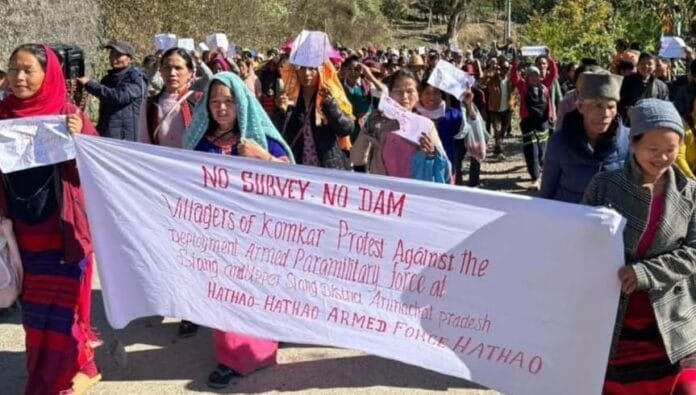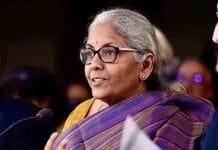Itanagar, Arunachal Pradesh – The Indian government’s Siang Upper Multipurpose Project (SUMP) has sparked widespread unrest and resistance across Arunachal Pradesh, especially among the Adi tribal community who call this biodiverse region their ancestral home. Despite its promise of hydroelectric power generation and regional development, the project threatens the ecological integrity of the Siang Valley and the survival of indigenous cultures intricately tied to this land.
Ancestral Lands Under Threat
The SUMP, launched in 2017, proposes a network of 43 massive dams across the river and its tributaries, including the Siyom and Yamne. If implemented, this mega-project will submerge extensive tracts of fertile farmland, sacred forests, and traditional hunting grounds, displacing thousands of indigenous families and disrupting centuries-old agricultural and ecological systems.
According to Vijay Taram, spokesperson for the Forum for Siang Dialogue, “We are on the verge of being displaced by all these developmental activities. Our language, forest, rivers, culture, tradition, and identity will perish.”
The Ecological Cost of Damming the Siang River
Arunachal Pradesh ranks among India’s most forest-rich states, boasting 67,083 square kilometers of forest and tree cover, as per the India State of Forest Report (ISFR) 2023. This dense green expanse forms a vital ecological corridor for wildlife and is crucial to maintaining the biodiversity of the Eastern Himalayas.
The construction of the SUMP will accelerate deforestation, degrade river ecosystems, and disturb the delicate balance of the region’s flora and fauna. Altering the natural flow of the Siang River is expected to:
Disrupt the breeding patterns of native fish species, many of which migrate upstream during specific seasons.
Deplete aquifers and groundwater levels, affecting agriculture and potable water access.
Cause irreversible damage to the habitat of endangered species such as the red panda, clouded leopard, and hornbills.
Increase the risk of landslides and flash floods in an already fragile mountain terrain.
Legal Loopholes and Forest Rights Violations
In 2023, the Indian government passed the Forest (Conservation) Amendment Act (FCAA), effectively bypassing local consent for forest clearances and fast-tracking infrastructure projects in ecologically sensitive zones. The amended Act removes the requirement to obtain Gram Sabha approval—a move critics claim was designed specifically to facilitate projects like the SUMP.
With the President’s assent in August 2023, the new provisions stripped indigenous communities of their legal recourse, allowing the government to proceed with massive deforestation without environmental impact assessments or public consultations.
This has triggered alarm among local communities and environmentalists who see this as a violation of the Forest Rights Act (2006), which guarantees tribal communities the right to manage and preserve forest lands.
Local Resistance Grows Stronger
On October 5, 2024, hundreds gathered in Upper Siang district under the banner of the Siang Indigenous Farmers’ Forum (SIFF). Their message was loud and clear: “Protect the Siang Valley or perish with it.”
Donggo Libang, General Secretary of SIFF, emphasized that the Siang River is not merely a water body but a lifeline for the Adi people. “At this critical point, collective actions are vital, which will bring an equitable solution for the future of the Siang Valley,” he said. Libang also called on the government to re-evaluate the SUMP and pursue sustainable energy alternatives that do not compromise the region’s environmental or cultural fabric.
Cultural Erosion: A Hidden Tragedy
The Adi community represents one of Arunachal Pradesh’s oldest indigenous populations. Their culture, festivals, and oral histories are deeply rooted in the Siang Valley’s geography. From the Ette (ancestor) worship rituals to agricultural festivals like Solung and Aran, the river and surrounding forests are integral to their spiritual identity.
Mega-dams like the SUMP pose a silent but devastating threat to:
Traditional farming methods passed down through generations.
Indigenous languages, which risk extinction with the loss of homelands.
Medicinal plant knowledge found only in these forest regions.
Oral traditions and folklore, closely tied to riverine and forest ecosystems.
As land gets submerged and communities relocated, the cultural disintegration will be as severe as the ecological loss.
Sustainable Alternatives and the Path Forward
Experts argue that Arunachal Pradesh’s energy needs and development goals can be achieved without destroying the ecological heritage of the state. Viable options include:
Decentralized solar and wind energy projects with minimal land footprint.
Run-of-the-river hydro projects that preserve the natural flow of rivers.
Community-managed microgrids tailored for remote, rural populations.
Eco-tourism initiatives leveraging the state’s unmatched natural beauty.
By investing in sustainable infrastructure, the government can avoid displacement, preserve biodiversity, and respect the rights of indigenous communities.
A Call for National and Global Solidarity
As India positions itself as a leader in green energy, the international community must scrutinize whether these energy transitions come at the cost of tribal displacement and ecological destruction. Arunachal’s forests are not just a regional asset but a global ecological treasure—home to some of the world’s rarest species and one of Earth’s last intact natural frontiers.
We must stand with the Adi people and other tribal communities of Arunachal who are defending not just their homes but the lungs of the Eastern Himalayas. The time has come to demand:
An immediate halt to deforestation for SUMP and other mega-dam projects.
A transparent, participatory environmental review process.
Restoration of indigenous land rights and forest governance.
Investment in ecologically responsible alternatives that honor both human and environmental dignity.
Conclusion: Preserving the Soul of Arunachal
The Siang Upper Multipurpose Project represents more than a policy dispute. It embodies a fundamental conflict between industrial progress and indigenous survival, between short-term gains and long-term sustainability. If implemented as planned, the SUMP may generate electricity, but it will do so by extinguishing a living culture, endangering a vital ecosystem, and erasing the identity of an entire people.
We must ask ourselves: At what cost are we building the future? And who pays the price?
As the Siang flows gently through the valley, so do the stories, songs, and struggles of those who have lived along its banks for centuries. Their voices must be heard. Their forests must remain standing. And their future must not be drowned.
















